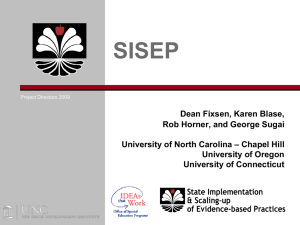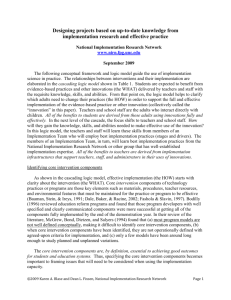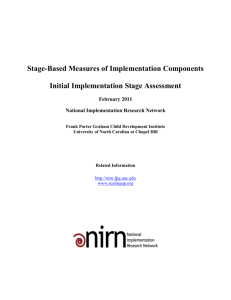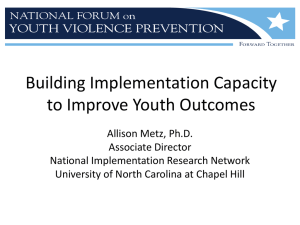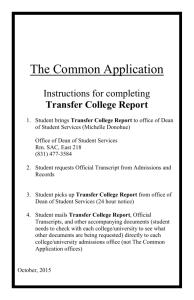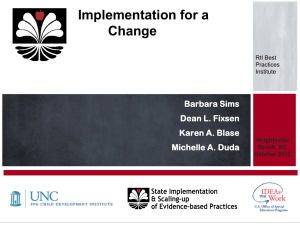View PowerPoint - University of South Florida
advertisement
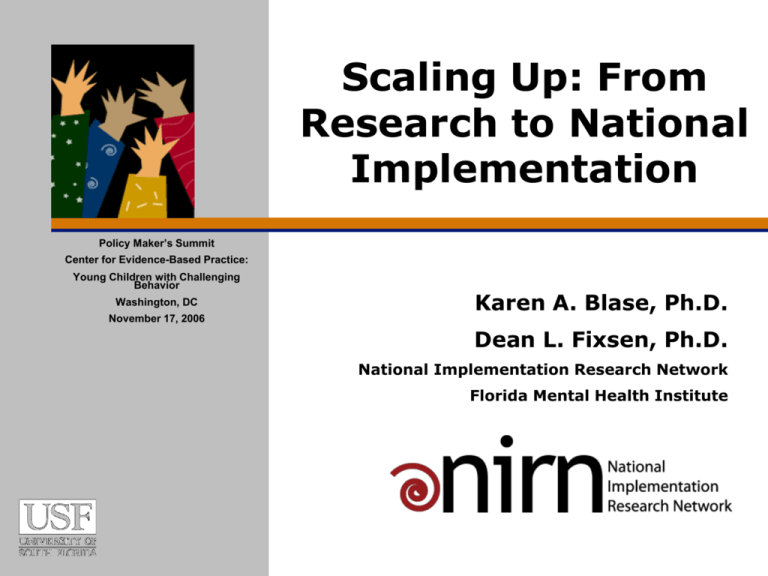
Scaling Up: From Research to National Implementation Policy Maker’s Summit Center for Evidence-Based Practice: Young Children with Challenging Behavior Washington, DC November 17, 2006 Karen A. Blase, Ph.D. Dean L. Fixsen, Ph.D. National Implementation Research Network Florida Mental Health Institute The Overall Puzzle Each year, more research is done More careful methods are crafted for reviewing research and identifying evidence-based practices and programs More attention is directed to evidencebased practices and programs in journals, conferences, and meetings Yet, it is a challenge to realize sustainable benefits for children, families, and caregivers on a broad scale Copyright © Dean L. Fixsen and Karen A. Blase, 2004 The Center’s Pieces of the Puzzle Focus of research has been on making a difference in the world…the child’s natural environment Wisdom and commitment to: Attend to values and “fit” for caregivers and children – What matters and for whom! Recognize multi-level influences (e.g. workforce development issues, policy, organizational culture) Build caregivers capacity and practitioner ability (e.g. attending to the independent variables) Inspire and create hope….tell the story and tout the science Copyright © Dean L. Fixsen and Karen A. Blase, 2004 Naming The Challenge Science to Service Gap What is known is not what is adopted to help children, families, and caregivers Implementation Gap “….While we have good evidence that the trajectory of a child’s social and emotional development can be changed, the field lacks the necessary information to ensure adoption and sustainability of these program practices…” Recommended Practices: Program Practices for Promoting the Social Development of Young Children and Addressing Challenging Behavior - Fox Copyright © Dean L. Fixsen and Karen A. Blase, 2004 Going to Scale: What Would It Take? How many implementations of a program or practice will be needed to address needs nationally? 800 child care and referral agencies 14,310 school districts 51,000 incorporated child care centers 906,993 children enrolled in Head Start 11.6 million children under age 5 (with estimates of 10 to 15% with mild to moderate problems) Copyright © Dean L. Fixsen and Karen A. Blase, 2004 Research to Service RESEARCH IMPLEMENTATION GAP Copyright © Dean L. Fixsen and Karen A. Blase, 2004 SERVICE The Implementation Gap It is one thing to say with the prophet Amos, “Let justice roll down like mighty waters,” and quite another to work out the irrigation system. William Sloane Coffin Social activist and clergyman Copyright © Dean L. Fixsen and Karen A. Blase, 2004 The National Implementation Research Network (NIRN) Craft knowledge EBP purveyors (program developers) EBP implementation site managers Implementation researchers Survey of EBP program developers Scientific information Program development and replication data Synthesis of the implementation evaluation and research literature Copyright © Dean L. Fixsen and Karen A. Blase, 2004 From the Synthesis of the Literature We Know That… Implementation issues are common across widely diverse domains Implementation solutions are common across widely diverse domains HOPE – Implementation research findings likely have broad practice implications across domains! Copyright © Dean L. Fixsen and Karen A. Blase, 2004 Puzzle Pieces Effective intervention practices and programs + Effective implementation practices = Good outcomes for children, families and consumers No other combination of factors reliably produces desired outcomes for children, families, and caregivers Copyright © Dean L. Fixsen and Karen A. Blase, 2004 Puzzle Pieces IMPLEMENTATION Effective INTERVENTION Effective Performance Implementation (High Fidelity) NOT Effective Copyright © Dean L. Fixsen and Karen A. Blase, 2004 NOT Effective Paper & Process Implementation (Low or No Fidelity) Puzzle Pieces Excellent experimental evidence for what does not work Dissemination of information by itself does not lead to successful implementation (research literature, mailings, promulgation of practice guidelines) Training alone, no matter how well done, does not lead to successful implementation Copyright © Dean L. Fixsen and Karen A. Blase, 2004 Puzzle Pieces Excellent experimental evidence for what does not work Implementation by edict does not work Implementation by “following the money” does not work Implementation without supporting role and function changes does not work Paul Nutt (2002). Why Decisions Fail Copyright © Dean L. Fixsen and Karen A. Blase, 2004 What Seems to be Required Integration of Implementation Factors Organizational Components: Influence Factors: Selection, Program Evaluation, Administration, Systems Intervention Social, Economic, Political Core Implementation Components: Training, Coaching, Performance Measurement Fixsen, Naoom, Blase, Friedman, & Wallace, 2005 Copyright © Dean L. Fixsen and Karen A. Blase, 2004 What Seems to be Required Successful implementation on a useful scale requires a purveyor An individual or group of individuals representing a program or practice who actively work with organizations and communities to help them implement that practice or program with fidelity and good effect Purveyors accumulate data & experiential knowledge to become more effective and efficient over time Copyright © Dean L. Fixsen and Karen A. Blase, 2004 Implementation Framework Organizational Structures/Culture Practitioner Purveyor Evidence-based Practices Fidelity & Outcome Measures Fixsen, Naoom, Blase, Friedman, & Wallace, 2005 Copyright © Dean L. Fixsen and Karen A. Blase, 2004 Implementation Framework Organizational Structures/Culture Infrastructure (Train, Coach, Evaluate) Purveyor Evidence-based Practices Fidelity & Outcome Measures Fixsen, Naoom, Blase, Friedman, & Wallace, 2005 Copyright © Dean L. Fixsen and Karen A. Blase, 2004 Active Purveyor Role Simultaneous, Multi-Level Interventions Practitioner Purveyor Organization Management (leadership, policy) Administration (HR, structure) Supervision (nature, content) Service Systems State, County and Local Context Federal Context Copyright © Dean L. Fixsen and Karen A. Blase, 2004 Purveyor Sources and Strategies Purveyor group organized and promoted by the originators (e.g. Success for All, Positive Behavior Support) Implementation team with the knowledge, skill, freedom, and authority to act (e.g. within a larger organization or a collaboration of agencies) An Intermediary Purveyor Organization that becomes expert in implementation and a “bridge” or expert with multiple EBPs (a new way of doing T & TA). Copyright © Dean L. Fixsen and Karen A. Blase, 2004 What Seems to be Required Purveyors Help Ensure the Integration of Implementation Factors Organizational Components: Influence Factors: Selection, Program Evaluation, Administration, Systems Intervention Social, Economic, Political Core Implementation Components: Training, Coaching, Performance Measurement Fixsen, Naoom, Blase, Friedman, & Wallace, 2005 Copyright © Dean L. Fixsen and Karen A. Blase, 2004 Implementation Drivers Implementation Drivers Coordinate and Operationalize the Core Implementation Components and the Organizational Components Implementation Drivers are mechanisms that Help to develop, improve, and sustain practitioners’ ability to implement an intervention to benefit children Help ensure sustainability and improvement at the organizational level Copyright © Dean L. Fixsen and Karen A. Blase, 2004 Implementation Drivers STAFF PERFORMANCE EVALUATION SUPERVISION & COACHING DECISION SUPPORT DATA SYSTEMS INTEGRATED & COMPENSATORY PRESERVICE & INSERVICE TRAINING RECRUITMENT AND SELECTION Copyright © Dean L. Fixsen and Karen A. Blase, 2004 FACILITATIVE ADMINISTRATIVE SUPPORTS SYSTEMS INTERVENTIONS Integrated and Compensatory Integrated Consistency in philosophy, goals, knowledge and skills across these processes (S/T/C/E/A/SI) Compensatory At the Practitioner Level At the Program Level Copyright © Dean L. Fixsen and Karen A. Blase, 2004 Implementation Drivers STAFF PERFORMANCE EVALUATION SUPERVISION & COACHING DECISION SUPPORT DATA SYSTEMS INTEGRATED & COMPENSATORY PRESERVICE & INSERVICE TRAINING RECRUITMENT AND SELECTION Copyright © Dean L. Fixsen and Karen A. Blase, 2004 FACILITATIVE ADMINISTRATIVE SUPPORTS SYSTEMS INTERVENTIONS Coaching Impact OUTCOMES % of Participants who Demonstrate Knowledge, Demonstrate New Skills in a Training Setting, and Use new Skills in the Classroom Knowledge Skill Demonstration Theory and Discussion 10% 5% 0% ..+Demonstration in Training 30% 20% 0% …+ Practice & Feedback in Training 60% 60% 5% …+ Coaching in Classroom 95% 95% 95% TRAINING COMPONENTS Use in the Classroom Joyce and Showers, 2002 Copyright © Dean L. Fixsen and Karen A. Blase, 2004 Stages of Implementation Implementation occurs in stages: Exploration Installation Initial Implementation Full Implementation Innovation Sustainability Fixsen, Naoom, Blase, Friedman, & Wallace, 2005 Copyright © Dean L. Fixsen and Karen A. Blase, 2004 2–4 Years Stages of Implementation Implementation is not an event A mission-oriented process involving multiple decisions, actions, and corrections Implementing an evidencebased program takes 2 to 4 years Copyright © Dean L. Fixsen and Karen A. Blase, 2004 Organizational Change: Top to Bottom Facilitate or Hinder Practitioners Settings System of care Active alignment of policies and coordination of efforts in support of practitioner’s use of effective practices to benefit children, families, and caregivers State policies. coordination, funding, support Federal policies, coordination, funding, supports Copyright © Dean L. Fixsen and Karen A. Blase, 2004 Policy - Practice - Feedback Study - Act Feedback Policy (Plan) Policy Structure Procedure Practice (Do) Practice Form follows Function Copyright © Dean L. Fixsen and Karen A. Blase, 2004 Organizational Change Successful and sustainable implementation of evidence-based practices and programs always requires organizational change at multiple levels. Changing the behavior of adult human service professionals Changing organizational structures, cultures, and climates Changing the thinking of system directors and policy makers Copyright © Dean L. Fixsen and Karen A. Blase, 2004 Getting From Here to There Who is going to do the work of implementation?....at each level? Who will be the “purveyors”? What/who will be the source of implementation drivers? Who will facilitate efficient and effective movement through implementation stages? How can we build the practice and science of implementation? Copyright © Dean L. Fixsen and Karen A. Blase, 2004 Summary We need to pay attention to implementation as a separate set of issues, strategies and procedures. We need to know more about the science of implementation. Implementation likely requires: Knowledgeable “purveyors” Implementation Drivers to support practitioner and organizational change (Select, Train, Coach, Evaluate, etc) Matching implementation activities to Stages Multi-level organizational change that creates alignment to support and sustain new ways of work (Federal, State, Regional, Local, Organizational) Copyright © Dean L. Fixsen and Karen A. Blase, 2004 Don’t mistake a clear view for a short distance. Grand Canyon Hiking Advice Copyright © Dean L. Fixsen and Karen A. Blase, 2004 Thank You We thank the following for their support W. T. Grant Foundation (implementation literature review grant) Substance Abuse and Mental Health Administration (ORC Macro sub-contract for SOC implementation analyses; Implementation Strategies Grant, Mental Health Services Gap Grant) National Institute of Mental Health (research and training grants) Juvenile Justice and Delinquency Prevention (program development and evaluation grants) Copyright © Dean L. Fixsen and Karen A. Blase, 2004 For More Information Karen A. Blase, Ph.D. Dean L. Fixsen, Ph.D. 813-974-4463 813-974-4446 kblase@fmhi.usf.edu dfixsen@fmhi.usf.edu National Implementation Research Network At the Louis de la Parte Florida Mental Health Institute University of South Florida http://nirn.fmhi.usf.edu Copyright © Dean L. Fixsen and Karen A. Blase, 2004
